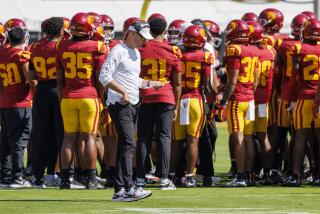Strip search
- Share via
Down in the basement of the USC athletic department, in the far corner of a windowless room where members of the football team’s defense meet each day, there is a black chair.
Set apart from rows of hard seats. High-backed. Cushy. With armrests.
It is called the “Strip King” chair.
Before you get the wrong idea, this specific piece of furniture awaits the player who, at the previous practice, made the most verified attempts to snatch the football from his teammates on offense.
“You want to be in that chair,” defensive tackle Fili Moala says. “Oh, dude, everyone knows you’re the Strip King.”
Call it a cheap prop, a teaching gimmick, but each fall the talk around USC football inevitably turns to turnovers. Nothing in the program is more revered, or constantly harped upon, by coaches.
Not breakaway runs. Not touchdown passes. Nothing.
“Being able to take care of the football, and take it away, will decide more games than any other factor,” Coach Pete Carroll says. “That’s why it is the No. 1 emphasis.”
With the third-ranked Trojans set to open the 2008 season at Virginia on Saturday, consider these numbers:
From 2002 to 2005, as the Trojans reemerged on the big stage by winning two national championships, their turnover margin -- how many times they swiped the ball versus how often they gave it away -- averaged plus-19.5.
Over the last two seasons -- no titles -- that average dipped to plus-three.
No wonder linebacker Rey Maualuga waxes nostalgic about former players such as Lofa Tatupu and Troy Polamalu, “guys who knew how to get the ball out.”
“We’ve got to get that mind-set,” he says.
The effort to revive the lagging turnover margin has focused on two areas.
Fans might know about “Turnover Wednesdays,” the weekly practice in which defensive players focus on interceptions and fumbles while the offense -- sometimes annoyed at all the grabbing -- tries to hold the ball high and tight. But there is another, more technical area.
Over the years, Carroll and his staff have tried to dissect the art of larceny, studying film, categorizing different types of takeaways.
“The more you can identify, the easier it is to teach,” secondary coach Rocky Seto says. “You don’t just tell them to go after the ball.”
Safeties are taught to shadow the receiver’s downfield shoulder on the post route, the spot they see as most likely to intercept the path of the ball.
When it comes to forcing fumbles, each technique -- punching at the ball, the overhand chop, the grab-and-rip -- corresponds with specific situations.
Defenders in a trailing position are told to watch for a glimpse of the ball, an opening to punch it free. Tackling from the side, they attack the leading tip of the ball. There’s also the “contact” fumble, a favored method when the receiver turns to catch a pass.
“You’re coming up from behind,” Seto said. “You blow them up and the sheer force of the hit might cause a fumble.”
All of this requires some degree of caution. Defenders can’t afford to whiff and let the runner break free.
So cornerbacks must think twice before cutting underneath a receiver -- if they miss the interception, it’s a touchdown. And tacklers are supposed to secure the ballcarrier with one hand before punching or yanking with the other.
The real feeding frenzy occurs during gang tackles, when one player wraps up the ballcarrier, leaving his teammates free to harass. Linebacker coach Ken Norton has his unit practice this scenario in the “bully” drill.
“That’s what he calls it,” Maualuga says. “Everyone goes for the ball.”
Virginia Coach Al Groh has compared the Trojans’ aggressive style to watching “opera or a good show.”
“If you’re an aficionado of aggressive run-and-hit, game-changing type defense,” he said, “you have to appreciate and enjoy watching the USC defense play.”
But the last two seasons suggest that technique goes only so far. Boosting the turnover margin might require something more elusive, something that Carroll describes as “the mentality.”
“Certain guys are not satisfied just making the tackle,” he says. “They’ve got to find their way to the football and try to get it away . . . the ball is the only thing they see.”
Is it a natural-born instinct? Can it be instilled through emphasis and repetition?
The answer could go a long way toward determining USC’s chances at another national championship.
The Trojans showed improvement in turnover margin over the final weeks of the 2007 season. In recent practices, the defense intercepted a string of passes and punched the ball out of receiver Patrick Turner’s arms.
“We’ve been getting to the ball in camp,” Seto says. “I feel like we’re coming along.”
Daily totals are listed on a tally board in the meeting room. And there is the chair.
It doesn’t recline or vibrate. Nothing fancy like that. But the defensive players seem to think it’s pretty special.
“I’ve only gotten to sit there a few times,” Moala said. “It’s the kind of thing where you want to get back.”
--
--
NO. 3 USC VS. VIRGINIA
Saturday at Charlottesville, Va., 12:30 p.m. PDT, Ch. 7
More to Read
Fight on! Are you a true Trojans fan?
Get our Times of Troy newsletter for USC insights, news and much more.
You may occasionally receive promotional content from the Los Angeles Times.







